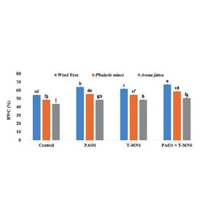Growth response of wheat and associated weeds to plant antagonistic rhizobacteria and fungi

Accepted: 23 July 2019
HTML: 104
All claims expressed in this article are solely those of the authors and do not necessarily represent those of their affiliated organizations, or those of the publisher, the editors and the reviewers. Any product that may be evaluated in this article or claim that may be made by its manufacturer is not guaranteed or endorsed by the publisher.
Wheat is the staple cereal crop of Pakistan but its growth is rigorously affected by associated weeds. Present study evaluated the synergistic effect of plant antagonistic rhizobacteria and fungi on growth, yield and suppression of wheat-associated weeds. Wheat associated weeds Phalaris minor and Avena fatua were grown in pots containing wheat as well. Pseudomonas aeruginosa strain PAO1 and Trichoderma harzianum T-MN6 were used as amendments to check their effect on two major weeds of wheat. The combined application of PAO1 and T-MN6 reduced the shoot length of Phalaris minor up to 30% and Avena fatua 40%, root length 22% and 28%, fresh biomass 29% and 31% respectively over their sole application. Similarly, inoculation of PAO1 and T-MN6 alone and in combination considerably enhanced growth, yield and physiological parameters of wheat. It was inferred from this study that the synergistic application of PGPR and fungi is a promising option to suppress major weeds of wheat and to enhance growth and yield of wheat.
How to Cite
PAGEPress has chosen to apply the Creative Commons Attribution NonCommercial 4.0 International License (CC BY-NC 4.0) to all manuscripts to be published.

 https://doi.org/10.4081/ija.2019.1449
https://doi.org/10.4081/ija.2019.1449



